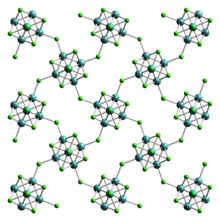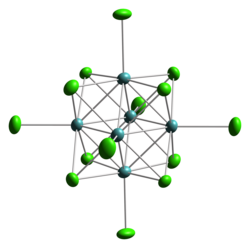Molybdenum(II) chloride

| |
| Names | |
|---|---|
| IUPAC names
dichloromolybdenum
dodecachlorohexamolybdenum(II) | |
| Other names
molybdenum(II) chloride, molybdenum dichloride
| |
| Identifiers | |
| |
3D model (
JSmol ) |
|
| ChemSpider | |
ECHA InfoCard
|
100.033.417 |
PubChem CID
|
|
CompTox Dashboard (EPA)
|
|
| |
| |
| Properties | |
| Cl12Mo6 | |
| Appearance | yellow crystalline solid |
| Density | 3.17 g/cm3 |
| Melting point | 530 °C (986 °F; 803 K) |
| low | |
| Related compounds | |
Related compounds
|
Molybdenum(IV) chloride
Molybdenum(V) chloride |
Except where otherwise noted, data are given for materials in their standard state (at 25 °C [77 °F], 100 kPa).
| |
Molybdenum dichloride describes chemical compounds with the empirical formula MoCl2. At least two forms are known, and both have attracted much attention from academic researchers because of the unexpected structures seen for these compounds and the fact that they give rise to hundreds of derivatives. The form discussed here is Mo6Cl12. The other molybdenum(II) chloride is potassium octachlorodimolybdate.
Structure
Rather than adopting a close-packed structure typical of metal dihalides, e.g.,

Synthesis and reactions
Mo6Cl12 is prepared by the reaction of molybdenum(V) chloride with molybdenum metal:
- 12 MoCl5 + 18 Mo → 5 Mo6Cl12
This reaction proceeds via the intermediacy of
Once isolated, Mo6Cl12 undergoes many reactions with retention of the Mo612+ core. Heating in concentrated HCl gives (H3O)2[Mo6Cl14]. The terminal chloride ligands, labeled "ausser" are readily exchanged:
- (H3O)2[Mo6Cl14] + 6 HI → (H3O)2[Mo6Cl8I6] + 6 HCl
Under more forcing conditions, all 14 ligands can be exchanged, to giving salts of [Mo6Br14]2− and [Mo6I14]2−.
Related clusters
A variety of clusters are structurally related to [Mo6Cl14]2−. The tungsten analogue is known. Ta and Nb form related clusters where halides are bridge edges of the Ta6 octahedron vs faces. The resulting formula is [Ta6Cl18]4−.
Sulfido and selenido derivatives are also well studied. [Re6Se8Cl6]4− has the same number of valence electrons as does [Mo6Cl14]2−.[3]
The Mo-S clusters Mo6S8L6, analogues of the "Chevrel phases", have been prepared by the reaction of sulfide sources with Mo6Cl12 in the presence of donor ligands L.[4]
References
- .
- ISBN 9780470132432.
- .
- ISBN 9780120236442.

